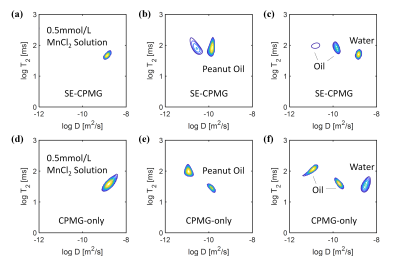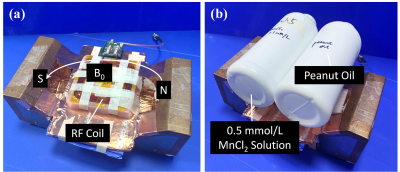Ziyi Pan1, Jieying Zhang1, Hai Luo2, Weiqian Wang2, Xiao Chen2, Ziyue Wu2, and Hua Guo1
1Center for Biomedical Imaging Research, Department of Biomedical Engineering, School of Medicine, Tsinghua University, Beijing, China, 2Marvel Stone Healthcare, Wuxi, Jiangsu, China
1Center for Biomedical Imaging Research, Department of Biomedical Engineering, School of Medicine, Tsinghua University, Beijing, China, 2Marvel Stone Healthcare, Wuxi, Jiangsu, China
The newly proposed
CPMG-only sequence without diffusion editing can achieve comparable D-T2
distributions for water/oil separation in single-sided NMR systems, compared with
the traditional diffusion editing SE-CPMG sequence.

Fig.
5 First column: the
unimodal distribution of the 0.5mmol/L MnCl2 solution. Diffusion and
relaxation coefficients measured by CPMG-only are identical to the
results of SE-CPMG. Second column: D-T2 distribution of the peanut oil.
Two different fat components are demonstrated. However the distributions,
especially for the T2 values are different. Third column: D-T2
distribution for the combination of 0.5mmol/L MnCl2
solution and peanut oil. Despite the differences in the D-T2 distributions,
both (c) and (f) show clear separation of fat and water components (three peaks).

Fig. 2 Details
of the single-sided NMR experimental device. (a) The arched magnet with the RF coil in the magnet center. The
geometry is designed to position the
device at the waist abdomen for liver detection. (b) Two different plastic bottles are placed inside the magnet,
filled with peanut oil and 0.5 mmol/L MnCl2 solution, respectively. The
experiment is designed to explore the sequences for separate characterization
of oil and water simultaneously.